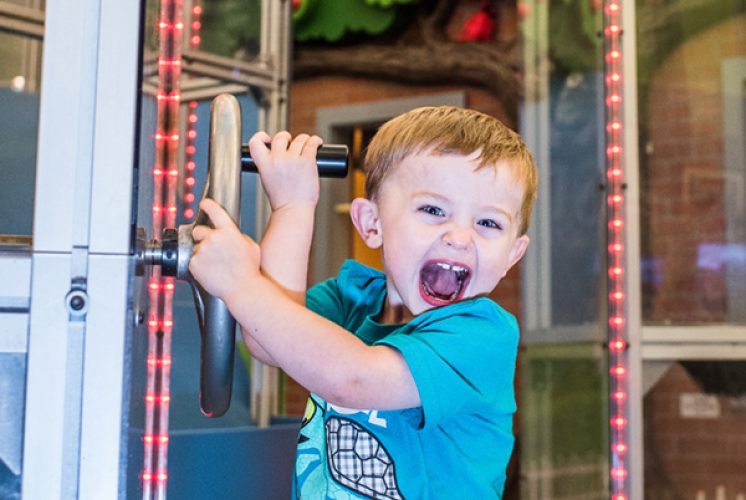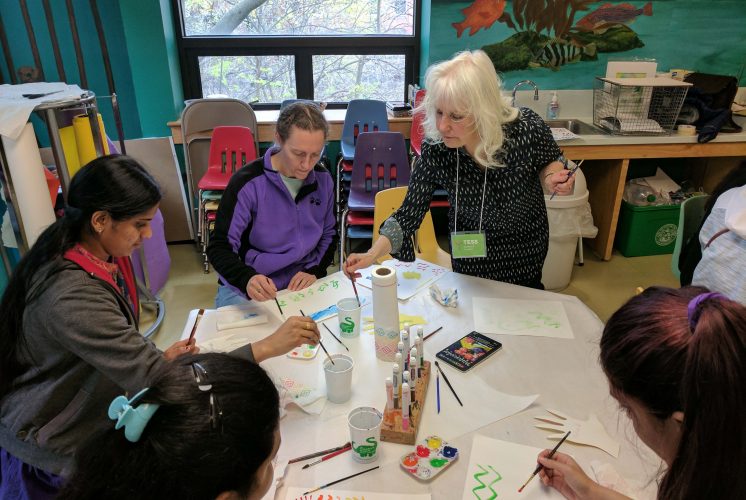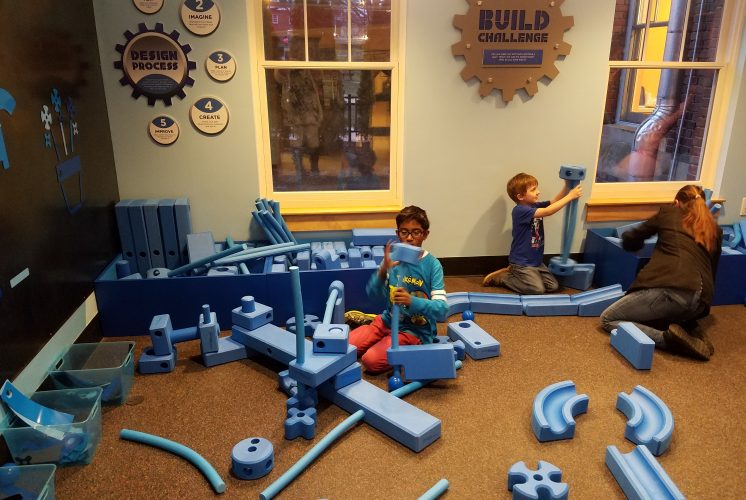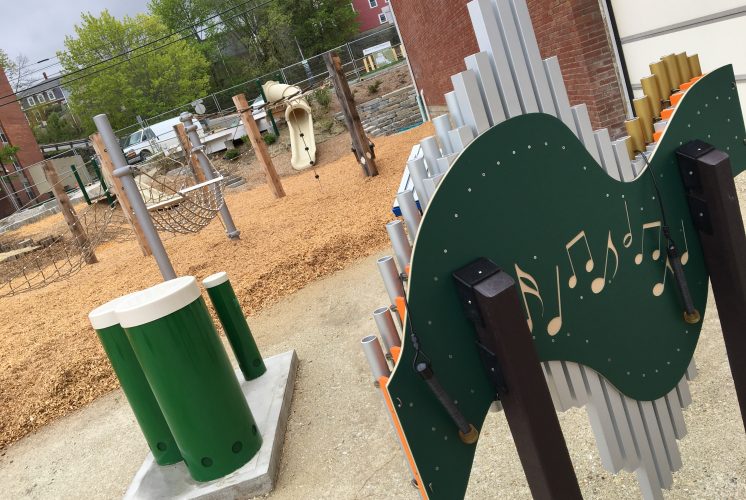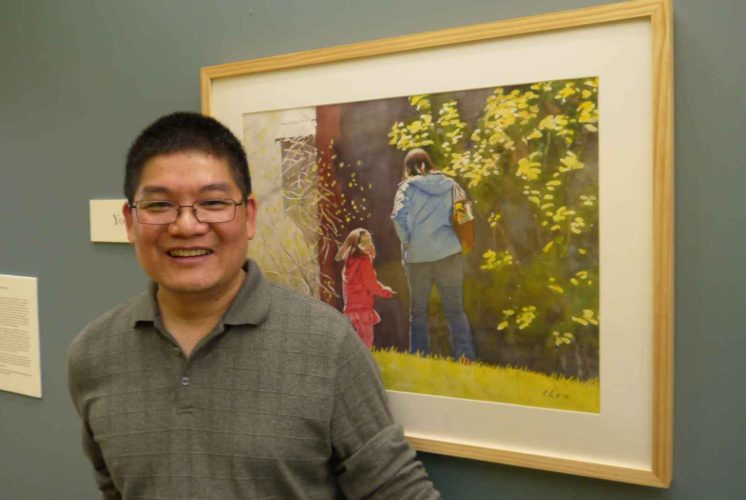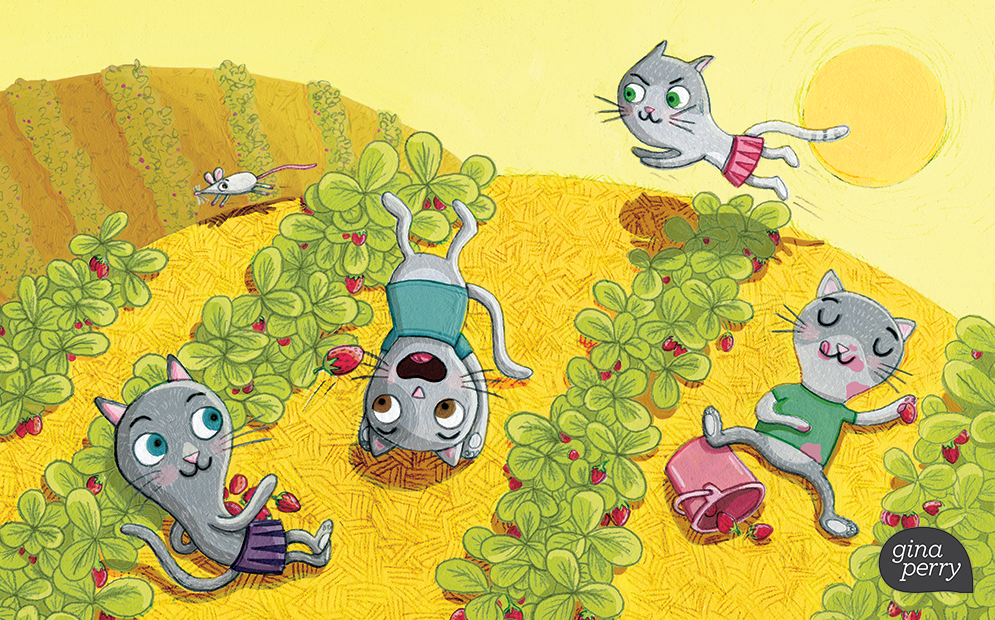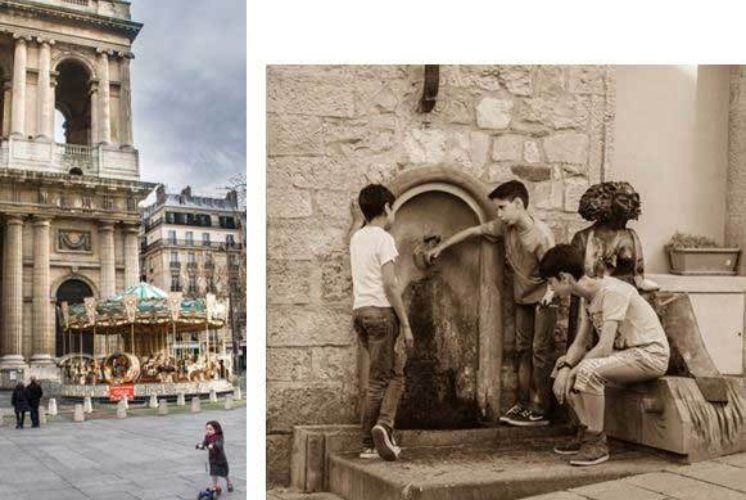The Museum Blog
Category: Exhibits
Gearing Up for a Bright 2018!
by Jane Bard, CMNH President
What’s new at the Museum? is the most commonly asked question when myself and my Museum colleagues are out and about in the community.
Before looking ahead, 2017 saw growth and change to best serve the 93,000 plus individuals we served last year. New experiences for our visitors included a new Thinkering Lab exhibit in January, to a major refresh of the iconic Build It-Fly It exhibit in the Fall, three new Gallery 6 exhibitions throughout the year, and the opening of the new Dover Adventure Playground outside our doors in June.
To deepen our impact, we created new curriculum-based programs for schools, our first-ever Grown-Up Play Dates and the We All Belong program for immigrant families. One of our most ambitious projects took place behind the scenes, an investment in a point-of-sales and database system that is helping us become more effective and efficient.
So what is in store for 2018? We will be celebrating our 35th anniversary and 10th year since becoming the Children’s Museum of New Hampshire and expanding in Dover by continuing to offer the same great programming and exhibits you’ve come to expect from us, while continuing to refresh these experiences and listening to the needs of our audience. Our One World exhibits will be getting a new life, introducing visitors to new cultures representing local immigrant populations through arts, culture and food. New signs within our exhibits will highlight the ways children are learning as they explore. Favorite programs and events will continue, while plans are underway for a special anniversary events in the summer and fall, so stay tuned!
Dinosaur on Loan!
T-Rex Takes over CMNH
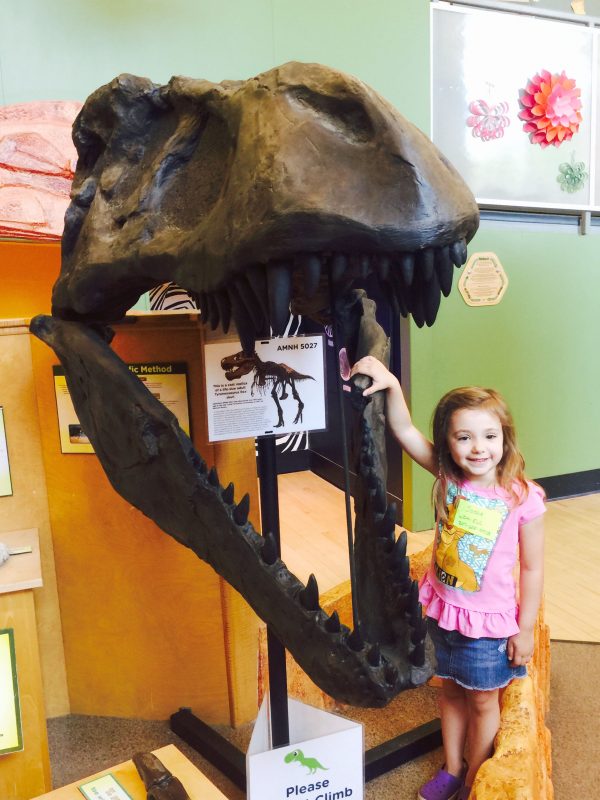
A visit to the Children’s Museum of New Hampshire in Dover just got a bit more Cretaceous! A life-size Tyrannosaurus Rex skull cast, along with a life-size footprint cast, have been loaned to the museum for the summer and now live in the popular Dino Detective Exhibit.
Generously loaned to the museum by Shawn Warren of The PAST, and made possible by the love and support of June Marie Warren and William Donald Warren of Neillsville, Wisconsin, the T. Rex specimens (known as AMNH 5027) join an augmented reality sand table, Triceratop fossil casts and an area to dig for fossils and make ammonite fossil rubbings.
“We’re very excited to have these replicas on loan to the museum,” said Eric Erwin, CMNH Exhibits Manager. “They make a great compliment to the hands-on pieces that make up our Dino Detective exhibit, and I have a feeling the kids will love posing with this giant skull and footprint!”
Specimen AMNH 5027, the fossil of an adult Tyrannosaurus Rex, was discovered over 100 years ago in the Hell Creek Formation of Montana in 1907 by Barnum Brown. The T. Rex, while living would have measured 20 feet in height, 50 feet in length and weighed 7 tons. The original skull fossil was on display at the American Natural History Museum in 1915, where it fueled a generation of imaginings about this towering and impressive carnivore. There have since been many additional discoveries of T. Rex specimens, and the AMNH mount is no longer the only or most complete T. Rex around. But, it was the first.
The Children’s Museum of New Hampshire is now open seven days a week for summer hours. Guests can visit anytime Mondays through Saturdays, 10am-5pm and Sundays, noon-5pm. Fun in all the exhibits is included with museum admission which is $10 per person for everyone over the ages of 12 months. Seniors 65+ pay only $9.
Unconventional Materials: Artist Interviews
Nancy Morgan
by Rebecca Scheinberg, CMNH Intern
Q. In your artist statement you mentioned having a background in dance. You also mention discovering and using the free-style quilting technique. I really enjoyed the technique used in the sky of your landscape pieces. It guides the eye all around the pieces in an organic way.
What is free-style quilting and how do you think it contributes to the layering and movement in some of your pieces? What was the reason you chose quilted fabric to create your image of Strawbery Banke/Goodwin Mansion?
A. Free style quilting refers to the setting on the sewing machine. Typically, a sewing machine moves either forward or backward. The fabric is propelled by teeth or "feed dogs" located under the fabric that pushes it along. With a switch on the machine the "feed dogs" drop under the surface of the machine thus creating a smooth working surface. This allows the user to draw with the sewing machine by freely maneuvering in any direction.
The stitching seen in the sky and most other parts of the quilt is called "Stippling". It is a meandering solid line that enables all the parts of the piece to be equally quilted.
All my pieces are quilts. There is batting in the center, a solid piece of fabric on the back and the front consists of several layers of individual pieces of fabric sewn down in layers much like a collage. My love of fabric comes from my background in dance and the many costumes I designed and sewed for myself and many others.
Danielle Festa
Q. I really enjoyed the depth created by your use of unconventional materials. Did the idea inspire the use of materials or vice versa? How did you apply the paint to the woven work?
A. The inspiration for the unconventional materials in my paintings starts from the moment I find my subjects. I bounce my ideas for the materials I will use off of what they were wearing in real life. "Woven" was actually hand woven with yarn inspired by my subject's hat. Before I could pick up an oil paint brush, I had to prepare the surface by spackling plaster, sanding it down and applying several layers gesso. A true one of kind piece and a labor of love, this painting took about 6 months to create!
Eve Corey
Q. Your paint application on the plastic pieces produces a sense of movement on a hard plastic material. What inspired you to use plastic and is there a meaning behind the portal series (3) in terms of texture and color choices? How did you create the layered effect of the plastic pieces?
A. I am interested in 'alchemy'--- turning something into something else. These piecs are picture frames used to frame photographs. I decided to make them into art.
I love working with the square and when I saw these pre-made frames, I challenged myself with the task of converting them into something else. I also love working with 'found' materials. A portal is an entrance, a doorway, a gate to some place else; just as these pieces are. Color choice is empirical- a matter of testing out different colors until something works and this leads to the texture, colors superimposed over others.
Michal Smiglowski
Q. You created birds out of wood and paper and created a scene that encompasses the birds and scarecrows in your piece of art. What inspired you to create this 3-dimensional box that created a scene using a variety of unconventional materials? Did the creation of the birds inspire the overall direction of the piece?
A. I usually get inspired by something I see. An article in the New York Times about scarecrows got me thinking about creating miniature versions. The creative challenge is taking that or any idea and transforming it into artwork; solving questions like what materials, design, frame work and style, etc, to use. I had already created birds so this was a great way to combine the two, and also play on a 'friendlier' version, where the birds are welcome instead of being scared away. The creativity for these could be endless.
Judith Cassell
Q. You used copper, silk and wood for one of your pieces. In another piece you used copper, wood, silk, sand and paper. There is a beautiful contrast of hard and soft material that creates a very textured and layered effect. What inspired your combination of materials?
A. I have been an observer as long as I can remember. Memories of a long life are stashed somewhere beyond my eyelids and surface in unexpected moments of creativity. One of my earliest memories was drawing in the dirt beneath the swing. I remember the softness of the soil on my fingers, the warmth of the sun on my back and the thrill of creation. Today, seventy plus years later, I am still thrilled by the magic created by an unknown self. I like working with metals particularly copper and rusted steel. I like the contrast of silk, paper, sand, etc., that together form the layers of my imagery.
Beth Wittenberg
Q. There are so many layers of images and lines in your pieces. Is this an organic process for you? What inspired you to use the acrylic and markers on vinyl? What inspired your design?
A. The process is organic indeed. I have nothing in my mind when I start. I have an urge after I hang the canvas as I ready myself to work. The urge comes as a cathartic explosion. I make marks and lines and shapes. My process leads me from one mark to the next. I build the composition without any thought to the images or marks. A lot of time I see eyes in what I'm drawing. The process is similar to looking at clouds. I look for patterns and eyes. I continue working until the picture plane is full with lines. Then I begin adding the color. Some parts of the painting come to the surface, while others disappear. I am constantly pushing and pulling different layers back and forth. I am hoping to get a hybrid. Something that lives in the various planes. My drawings/paintings are inspired by my spirituality. They are about a relationship with something other. I am simply a medium for the creative energy that lives inside me.
The use of markers/acrylics on vinyl is inspired by spacial dimensions. I love how all of the layers lay on top of each other. This is achieved by the vinyl - it's see through. Lines sing to me and the layers play mind games with me.
Lin Thorpe
Q. Your illustrations of dinosaurs on the black converse children's shoes are beautiful. What inspired your idea to paint dinosaurs on converse kid shoes?
A. I have been illustrating on Converse sneakers for many years. My first pair was a special request from my son, then 15 (he's now 43) for a pair of dinosaur sneakers like the little kids had. He couldn't understand why only people with small feet could have such fun shoes! So I bravely tried a new type of "canvas" and painted a pair of size 11 light blue Converse Chucks with acrylic paint. He wore them proudly. Since then I have painted many pairs with very diverse subject matter, mostly for children but some for individualistic adults: frogs and amphibians; insects, beetles and tarantulas; exotic flowers; butterflies; seashells and sea life; and even images of Greek mythology done in Greek red-ware style. Each pair is a challenge and it is rewarding and fun to see people wearing a bit of my artwork on their feet.
I now illustrate on almost any surface I can find - shoes, furniture, rocks, fabric, driftwood, and of course paper. It's fun to transform an otherwise uninteresting surface into a creative, and often useful, work of art.
Barbara Albert
Q. You created a piece using acrylic with plastic netting and plastic lids. Your piece has a beautiful combination of texture and movement. What inspired your color choices with your unconventional materials?
A. As an abstract painter fascinated by texture and color, I was delighted to share “Blue Bird with Oranges” with Gallery 6 visitors. Painting is play for me – a series of “what ifs…”. This painting surprised me with a surprise blue bird when I stepped back to see where the color on the canvas was taking me. I squeezed red and yellow paint right from the tube onto the canvas and “squoooshed” them with clear plastic lids. Like magic, they turned into oranges for my blue bird to eat! The painting evolved with happy purples and blues that told more of the bluebird’s story. If you listen carefully, can you hear his “thank you” song?
Caryn Duncan
Q. You used CDs layered on top of records and paint to create beautiful mandalas. In your artist statement you mentioned utilizing objects that are being discarded and replaced with digital media. You also shared that mandalas represent the meditative practice in art. Did your choice of materials inspire you to create the mandala?
A. I draw inspiration from the belief that art makes a positive difference in the world. Spirituality is an essential aspect to my creative practice. There are a variety of spiritual elements, symbols, and personal beliefs that I weave into the layers of my paintings. The meditative practice of creating Mandalas supports my interest in sacred art. I choose to utilize materials that would support the radial balance design of Mandalas. Using unconventional materials that are discarded supports my belief that as artists, we can make powerful visual statements to convey messages. It is my hope that humans can cut back on the waste that goes into landfills, that we try to reuse and extend the life of items that are being discarded. This comes from my deep care and appreciation of nature and preservation of the earth.
Taintor Child
Q. You used re-purposed polystyrene packaging, paint, metal leaf and mirror to create beautiful and functional mirrors with "frames". Did the materials inspire the design idea or vice versa?
A. The materials definitely inspired the idea to create the mirrors. I had been working with the polystyrene packaging for a couple of years to create standing sculptures and found a number of pieces in my collection that had windows that were already a frame of sorts. I had a show coming up and wanted a collection of new works to hang and decided to play with the mirror idea. The concept that we are looking through a piece of EPS at ourselves got me jazzed. Yes, EPS is a problematic by-product of consumer waste and the question of what do we do with all this stuff we create is hopefully a question that arises when looking at oneself in these pieces. The other message I want to convey is that it is a beautiful creation, the molded shapes of EPS are designed by packaging experts to nestle and protect out beloved treasures. Then what? So many people will say to me, I hate to throw this stuff away. I think we save it in part because it is sculptural and we find it interesting. What do you think?
Joe Kennedy
Q. Your work has a playfulness and whimsy about it. There is a sense of heaviness from the plumbing materials and lightness from the glass materials. What inspired your combination of using plumbing materials with glass to create these sculptures?
A. I’ve come to love the combination of metal and glass over time. Almost immediately when I started experimenting at my bench, I found myself working to incorporate glass because it was available. I delighted in the discovery that both materials work so well together despite their stark differences. The metal, being heavy, dense and dark, in contrast to glass with its sense of lightness – it signified the water that once flowed through the transformed plumbing parts.
I only work with glass that allows light to pass through. It becomes a portal to another world and brings in color. Marbles were the first type of glass I used quickly followed by many other forms such as mirrors, magnifying lenses, domes, containers, vases, etc. I often use glass for stands, shrines, finials and many types of display. I’m prone to using some sort of glass encasing such as domes for a number of reasons – It elevates the piece to a higher level, keeps the dust off and it naturally keeps people from handling a delicate piece of sculpture. Also, as you noticed, it enhances the overall quirkiness of my work adding to the obvious whimsy and playfulness.
Elizabeth Doherty
Q. Did your love of dragonflies inspire you to find ways to create them using unconventional materials? Did you know the materials you wanted specifically or did you find the pieces and construct as you went along in your design process?
A. I knew I wanted to make dragonflies. I was thinking at first the wings would be made of layered recycled bags fused by heat and transparent but then I found the license plates.
I researched some ideas from the inter web and a rummage through my dads workshop (the basement) and the cuties came together.
MUSE Studio gets Reinvented
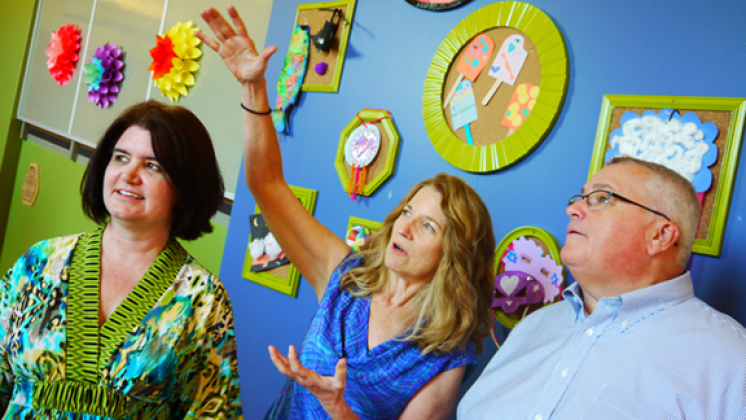
Thanks to D.F. Richard, one of the Children’s Museum of New Hampshire’s busiest spaces, the MUSE Studio, is getting a makeover. For the past eight years, museum visitors of all ages have engaged in creative activities and challenges in the MUSE Studio. “Activities change every month here in the MUSE Studio,” shared Meredith Lamothe, CMNH Early Childhood and Literacy Coordinator, “the equipment and furniture needs to be versatile so we can use it in many different ways.”
The Studio now features a newly designed magnet table, inspiring artwork by local artist Sam Paolini, new technology for storytelling with a computer kiosk and an Elmo projector, a burlap-covered sewing table for collaborative art-making, and a pegboard table that can be taken on the road for the museum’s outreach programs. Renovations also include new tables and chairs, and of course, new art supplies.
Some other new features might not be as noticeable, but are equally important. The MUSE Studio also has a host of new picture books, open shelving for displaying artwork, and a curtain wall that will be utilized during special events like the popular Books Alive character appearance.
All MUSE Studio activities are free with museum admission. Muse Studio revitalization is supported through the generosity of D.F. Richard.
Everything Under the Sun: Artist Interviews
Susan Mariano, CMNH Intern
Barbara Albert
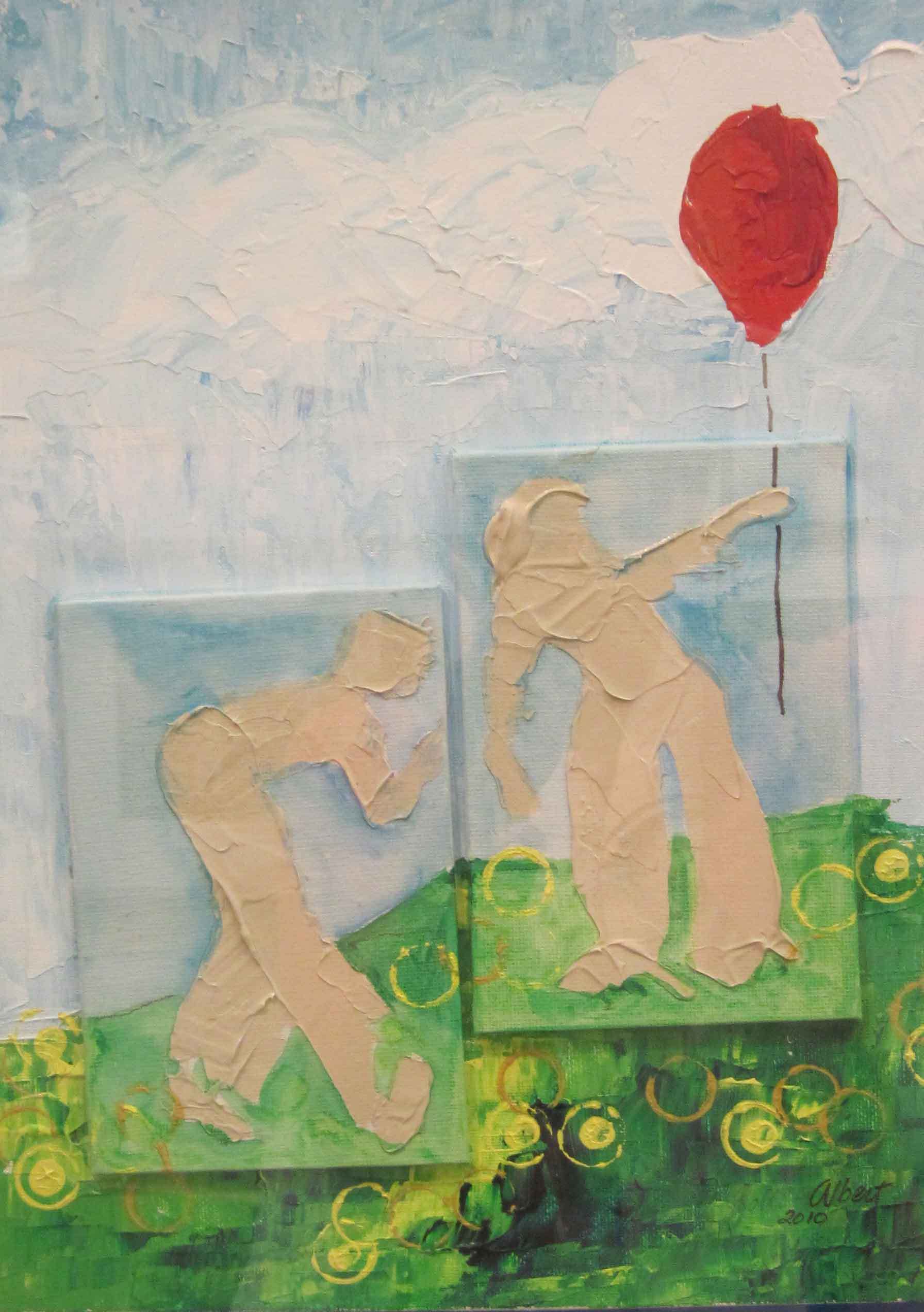
Q. Barbara, I really like the way that you have added dimension to your painting by affixing the smaller canvases of the two children on top of your hillside background canvas. The way the string of the balloon appears in the foreground and balloon itself in the background, makes it seem as though the balloon belongs to the children, yet has a separate existence of its own outside of their play.
What feeling or message are you hoping to
invoke with the viewers of “The Red Balloon”?
A. Children often struggle with sharing. My painting of two kids with a red balloon, tells a story about making choices. Look closely at the boy on the left. Does the way he is standing suggest that he wants to hold the balloon, too? You can feel the boy wanting to hold the string while the girl on the right seems unwilling to share her prize. Do you think the girl on the right will let him? Will he convince her to let it go? Will the balloon escape at first opportunity? If it was your balloon would you share it?
Yong Chen
Q. Yong, the detailed facial expressions in your paintings are very moving and being able to watch you actually paint a portrait during the artists’ reception was incredible! The watercolor paintings that you have chosen for this exhibition truly capture the emotional element of childhood play when there is not a care in the world but the moment that you are living in, and the sense of security found in spending unhurried, quality time with treasured parents.
What is it that
catches your eye and creates the desire within you to paint a particular
person?
A. Whenever I see happy children under the sun, I want to put them in my paintings, because I would feel the genuine, unselfish love from the parents. I hope that my paintings will inspire my viewers to spend more quality time with their children.
My core belief that guides my parenting is that children are happier when they're outside, in the sunshine, playing, enjoying, exploring and learning about the wonderful world they live in. I'm experiencing the same struggle as most parents do of how to balance life and work in the modern technologically obsessed environment around us. For many working parents, it is very difficult to consistently make their children the priority. In each of my watercolor paintings in this series, there is one story to tell, and behind it a very happy child. We should see the love, caring and sacrifice from the parents. As an illustrator, I am trying to use my paintings to connect the parents with their own happy childhood memories, when in those times there was not much technology, and share my thought with them that they should make time to bring their children outside and play.
Taylore Kelly

Q. Taylore, the golden circular shapes in the center of all of your mixed media artwork convey a sense of warmth and security, as they surround the delicate creatures within.
What statement are you making with the vintage printed backgrounds that you have chosen for each of your pieces?
A. I like to up-cycle the vintage pages from damaged antique books that would have otherwise found their demise and give them a new life by creating on them.
Q. Would you share your thoughts on your unique title choices?
A. Then All the Sky Which Only, the hummingbird, has the specific background because I saw the sentence, “Nature of Matter and Mind” within it and I turned it into my belief system of nature being grace, and that I do not understand, nor do I need to understand the mystery of grace. The title is simply a sing song way to say “Look what the sky holds! Hummingbirds!” Words have melody when we look and search.
By All and Deep by Deep, the whale, has a mathematical equation background because when I squinted my eyes the equations looked like music notes. Well let’s be honest I am far sighted and thought, indeed they were music notes. I love the songs whales sing. The title is because whales seem to live very deeply on all levels, figuratively, literally, musically, richly.
Whatever a Sun will Always Sing is You, the fox in the eclipse, is on a page about insanity, but the page is reversed. Tarot Cards meanings at times will be the complete opposite if inverted. Actually a lot of symbols mean the opposite when inverted. A subliminal message of how rabies seem to get these lovely creatures quite often, but not this one. She is sleeping in a soft eclipse of her own music.
Open You the Biggest and All, the deer, is in a sun nest. She is open and feels one with the Universe and what is bigger than that? I can not think of anything. She is on upside down equations as well because I thought they were music notes. Sometimes these things happen and I just flow with them!
Gina Perry
Q. Gina, I really love the way that your colorful illustrations have captured the whimsy of a child’s imagination, the details that you put into your work, and how each person and creature is sharing time with others, yet in their own little world.
What made you decide to become an illustrator?
A. My short answer is usually that a very big part of me is STILL a child, and I'm making pictures that make that part of me happy! But here is the long answer, as well. Books were a huge part of my childhood. They allowed me to see into other worlds that as a child I couldn't travel to on my own. I also loved art from a young age but never thought of illustration as a career path until I was in art school. Even then, I studied computer animation - and I think what most attracted me to that profession was the visual storytelling. Once I was working in animation, I understood how little personal vision I could put into a project and that I wasn't working with the audience I loved the most - children. I didn't put the pieces together until I was taking a children's illustration class - suddenly I knew exactly what I wanted to do! It really felt like a light deep inside me finally clicked on. I love learning, so I soaked up everything that would help me reach my goal. Over the years I took lots of classes, joined critique groups, attended conferences, read mountains of picture books, and worked incredibly hard to find a place in children's book illustration.
Q. Do the authors set “rules” for you limiting you to their vision or do you get to express what you see within your own imagination?
A. Most projects allow me to set lots of rules - from how the characters look to the size of the book itself and where the text breaks up throughout the book. Other projects come with more guidelines, usually from an editor or art director, but there is always room for my own approach and vision. Finding ideas and characters that the author didn't originally state, but that add to the story, is one of the most exciting parts of my job!
Q. What medium to you use to craft your illustrations?
A. I use a mix of gouache (opaque watercolor), soft pencils and Photoshop.
Michal Smiglowski
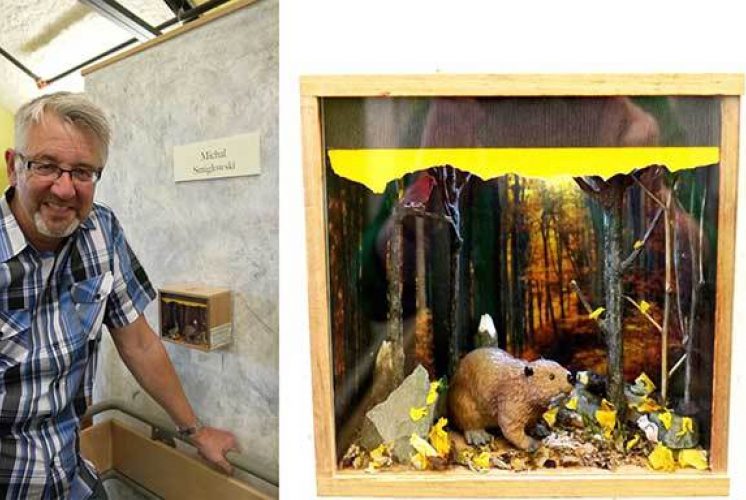
Q. Michal, you are known for drawing incredibly detailed black and white penciled portraits and illustrations. In this exhibition you have traveled in a totally different artistic direction, leading you to the creation of fascinating 3-dimensional, illuminated worlds inside of cigar boxes. In conversation you eluded to a future endeavor using yet another medium.
Please share what it is that truly inspires you to boldly go where you have not gone before.
A. On a visit to our favorite Maine 'Dowling Walsh' Gallery, located in Rockland, we came across artwork the likes I had never seen before. I was immediately fascinated by the medium, craftsmanship and story. The artist is Anne Emmanuelle Marpeau from Brittany France. The works were of dioramas of the coast, sailing and sea. I was so taken with them I got to thinking about creating something similar on a smaller scale, and so after much experimentation and development my boxes were born.
Less exacting than my pencil portraits and entirely different, I
loved the change in medium and the unending and imaginative ideas you
could create.
I am always coming up with new ideas and creative projects, adding
them to my repertoire of artworks. The part I quite enjoy is figuring
out (engineering) how these 3 dimensional projects can work, and yes, I
have yet another idea in my mind… here we
go again. It's so much fun!
In the world of hi-tech, the hand-crafted creative is both rewarding and therapeutic.
Debra Woodward
Q. Debra, I like that you selected photographs of children from France, Mexico and Italy for this exhibition as your photos serve as a reminder that the essence of being a child has no international borders. Your statement that “Photography is so much about ‘seeing’ and not just taking snapshots,“ rings so true with your photographs. As the viewer continues to gaze at one of your photos, it seems that there is more going on than just a quick glance can reveal.
Do you see these nuances as you are taking the photo or discover afterwards that they were what compelled you to capture the image?
A. Thank
you for saying that my photographs are not snapshots, but more about
seeing. That is what I strive for. As for whether capturing the
essence of being a child was intent or a lucky result of my shooting
(which I admit can absolutely happen!) on those days in Mexico, Paris
and Tuscany, I think I can fairly say that with these particular photos I
was excited to see what was happening in the world around me and sought
to capture the moment. The child in Mexico was playing with some of
the jewelry that her parents crafted and sold and I could see that she
was just so beautiful. In Tuscany, I shot many images of those boys
playing soccer but was happy that I stuck around to photograph
their camaraderie afterwards. And in Paris, I was very excited to
see that little girl on her scooter in front of the carousel. It was an
image I would never be able to capture close to home. It was so
Parisian. She reminded me of the little girl in the Madeline books!
Farewell to Mark Cuddy
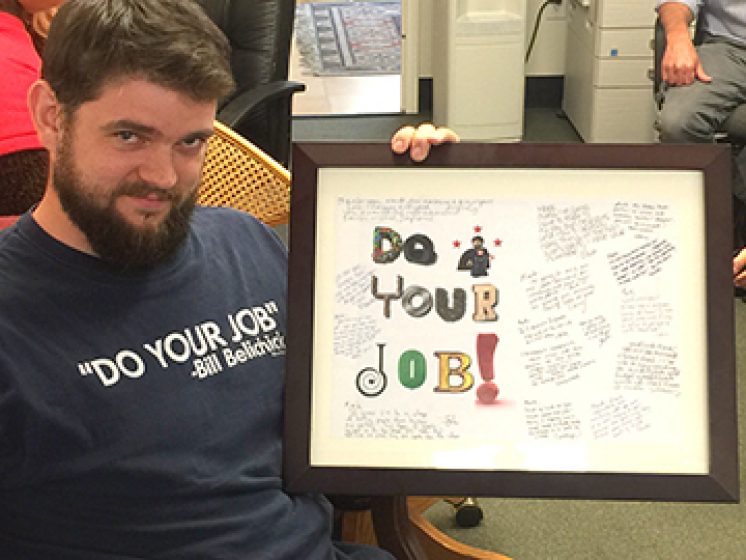
Sadly, Exhibits Director Mark Cuddy is leaving the museum after 5 years of designing and building amazing exhibits at the Children’s Museum of New Hampshire We are all very sad to see him go as he has always been a solid contributor to CMNH. I sat down with Mark and asked him to reminisce a bit on his time here at the Children’s Museum.
How long were you at the museum?
Just about 5 years.
What made you want to work at CMNH?
I was working part time at the Children's Museum in Easton and was looking for full time work at a children's museum. I saw the job opportunity here in NH, came for an interview, and really liked the museum, the exhibits and the workshop space downstairs so I applied and was lucky enough to get the job.
What are some of your typical duties as Exhibits Director?
I oversee everything that has to do with the exhibits, so it varies day to day. Some days it might be maintenance on something that broke the day before, it may be trying to re-design an exhibit component so it functions better, or it may be planning, designing or building a new exhibit.
What are you going to miss the most about your job?
I like the workshop, and I like working on the whole design process from initial ideas and concepts all the way through fabricating and installing the exhibit.
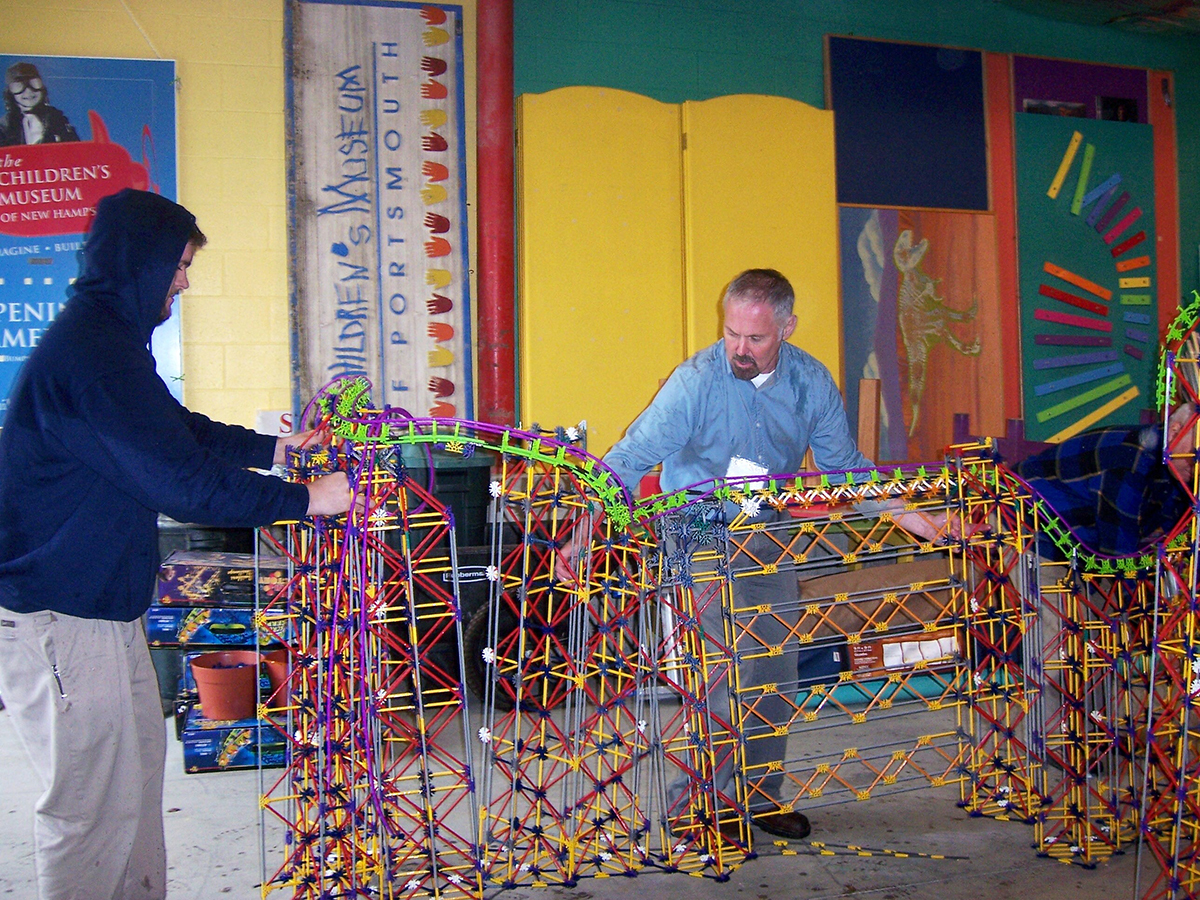 Any cool stories about building exhibits? Setting them up? Challenges?
Any cool stories about building exhibits? Setting them up? Challenges?
I've learned a lot and had to figure a lot of things out along the way. We set up 2 temporary exhibits with K'nex called Colossal Construction, so I got to build all sorts of cool roller coasters and ball ramps. Some of them worked better than others, but it was a fun process. The roller coaster by Primary Place was supposed to be a temporary installation but it has been so popular that we have kept it for years.
Any crazy exhibit ideas that you wish you could have done but never happened?
Not really, I tried to keep our concepts and ideas to what I thought we could actually accomplish. I didn't want to suggest something super cool, but crazy, and not be able to follow through on the idea.
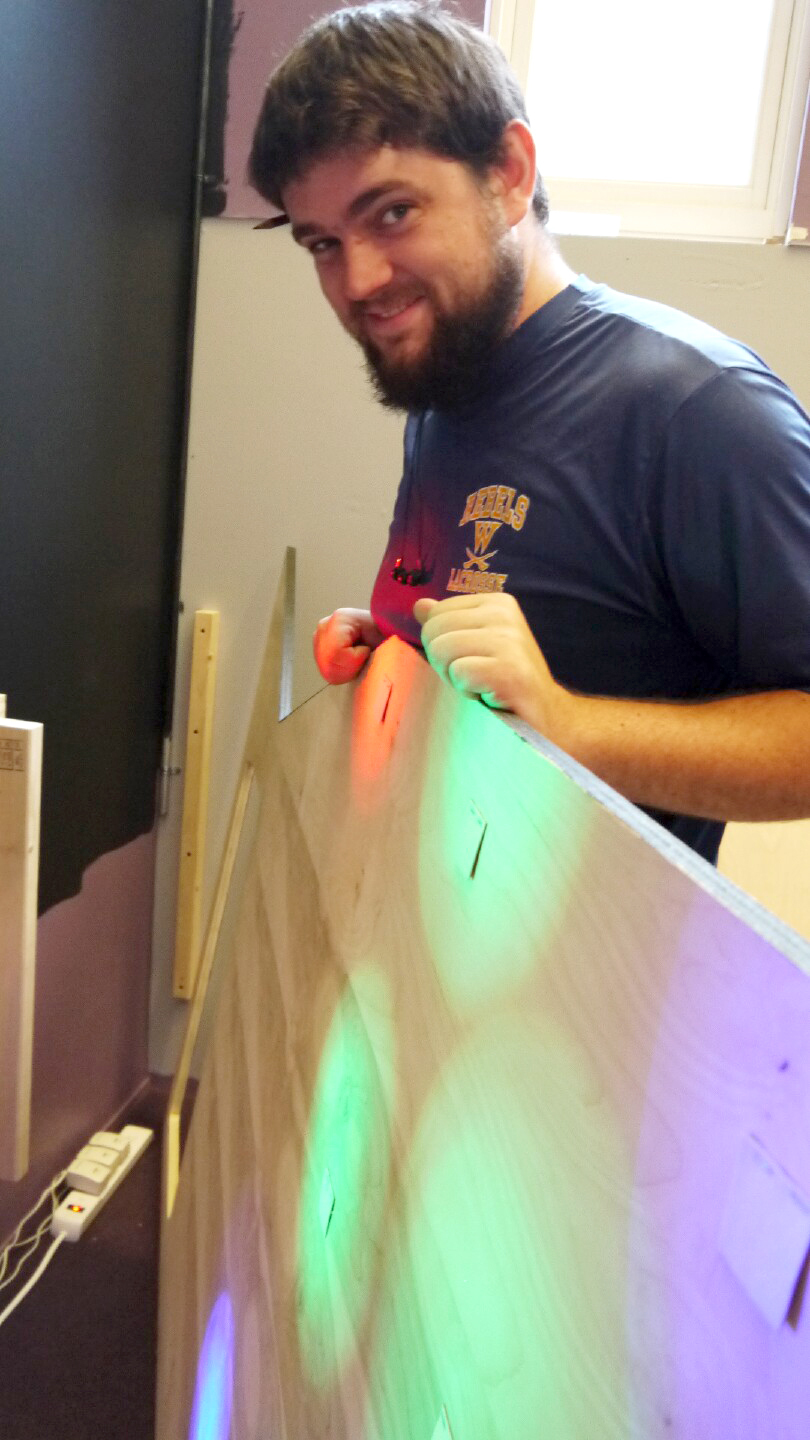 Is there an exhibit you created you are most proud of?
Is there an exhibit you created you are most proud of?
I'm not sure if I can pick just one. I like the Cave Explorers exhibit because that is a different, dark environment that provides a different experience for children and families. That was a whole exhibit that I designed and built. I also like the updates we made to the green screen exhibit, now called Adventures in Travel, because we used existing technology that we had, but were able to update and enhance the experience.
Where are you off to now?
I'm going to Garrison City Beerworks to work full time there, being a jack of all trades and assisting in the entire process of brewing, from cleaning and sanitizing, to brewing, to canning the beer, and any maintenance tasks to keep things running smoothly.
Anything you’d like to say to your co-workers or the families who visit?
To the co-workers, I know you will miss me.
We will miss you too Mark! On behalf of all the employees and guests at the children’s museum we thank you for your hard work over the last 5 years and wish you well on your exciting new opportunity at the brewery!
MOSAIC: Artist Interviews
By Susan Mariano, CMNH Intern
BECKY FIELD
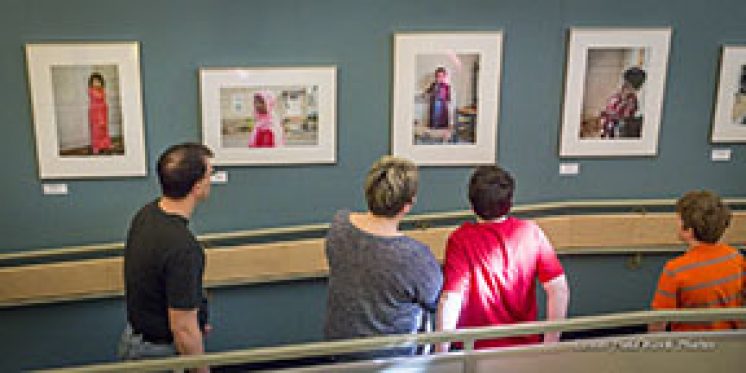 Q. Your photographs capture the optimistic joy of childhood and the strong desire to embrace and rejoice in the freedom to express, celebrate and share one’s colorful cultural heritage. While the immigrants and refugees from Africa and Southeast Asia may outwardly look and dress differently than those born here in the United States, they share many of the same family values as their fellow American-born neighbors and should be respected and appreciated for their differences.
Q. Your photographs capture the optimistic joy of childhood and the strong desire to embrace and rejoice in the freedom to express, celebrate and share one’s colorful cultural heritage. While the immigrants and refugees from Africa and Southeast Asia may outwardly look and dress differently than those born here in the United States, they share many of the same family values as their fellow American-born neighbors and should be respected and appreciated for their differences.
Many of the people you have immortalized on film have come to New Hampshire seeking safety and a better life for their children. However, it was a shameful local act of hate that inspired you to begin your photographic journey. What signs have you seen that the tides of understanding and embracing cultural diversity are changing here in New Hampshire?
A. The act of hate that inspired me to do this photographic project was immediately countered by a large community response that started the "Love Your Neighbor" Coalition. The hate was from one person, the response was from a whole community. Since then, my photography has been shown in many exhibits and talks that I have given in several New Hampshire communities. I have seen in the response to those events that feature the lives of our immigrant and refugee neighbors, and in the out-pouring of interest in by book, Different Roots, Common Dreams, that there is a growing interest and desire to welcome for people of different cultures who resettle in our communities. Through these photographs, the broader public has come to know our immigrant neighbors, and that knowing has planted the seeds of understanding and compassion.
SKIP SMALL
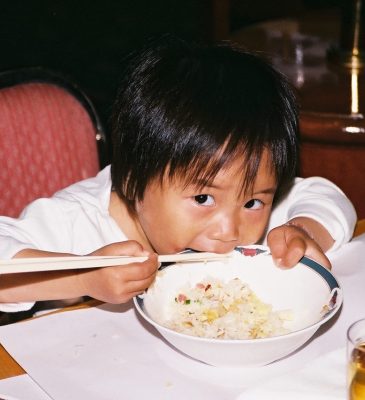 Q. The photographs you have taken of Chinese children living their everyday lives, hanging out with friends, riding on a bicycle and playing outside in the dirt illustrate that the simple things that bring one joy during the days childhood are pretty much universal.
Q. The photographs you have taken of Chinese children living their everyday lives, hanging out with friends, riding on a bicycle and playing outside in the dirt illustrate that the simple things that bring one joy during the days childhood are pretty much universal.
As a retired pediatrician who accompanies groups of prospective parents on the journey to meet their adoptive children for the first time, what would you like to say to couples who are considering becoming parents to children from other cultures?
A. My advice to people thinking of adopting children from a different culture would be no different than I would give to any potential parents. Raising children is a demanding challenge whether they are naturally yours, adopted from your culture, or adopted from a different one. If you are afraid of challenges, don’t have kids. If you embrace challenges, go for it!
SAYAKA and SETH BLEWITT
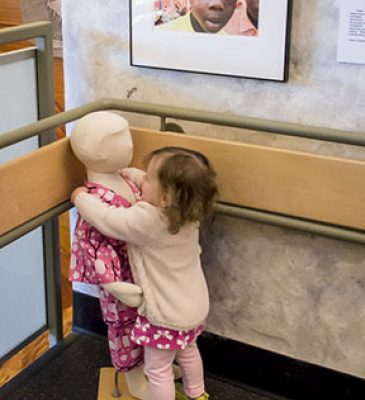 Q. The images and objects that you have curated, providing a glimpse into the life of a child from Japan, were uniquely enlightening. Finally, I understand the significance of the Japanese cherry blossoms! The celebrations of Hina Matsuri and Tango no Sekku show how truly important and respected children are in the lives of the Japanese.
Q. The images and objects that you have curated, providing a glimpse into the life of a child from Japan, were uniquely enlightening. Finally, I understand the significance of the Japanese cherry blossoms! The celebrations of Hina Matsuri and Tango no Sekku show how truly important and respected children are in the lives of the Japanese.
What message are you hoping the people who view your collection will take away with them?
A. I'm glad that the exhibit had that effect of providing some insight into Japan through a child's eyes. Think of the first moment when you saw the topics posted on the wall of the
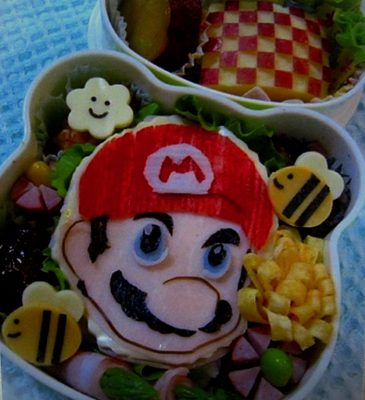
Curiosity, wonder, bemusement, and excitement for something new are a little harder to come by when you're older, unless you look for it. In exploring another culture, adults can feel like a kid again because they encounter a barrage of new experiences. So hopefully in the short term visitors, adults and children alike, have found these wondrous emotions. And in the long term I hope that this exhibit has motivated adults to seek out new experiences for themselves and to share with others.
Rocks Rock!
Now on view in the Naturalist Study
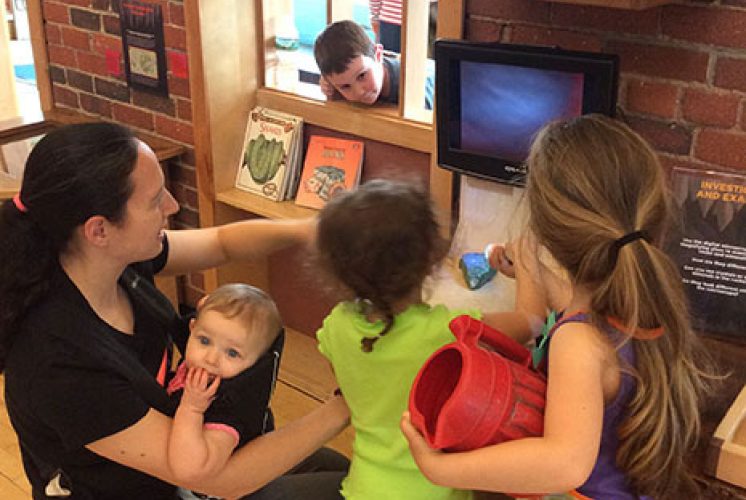 We have a great collection of rocks, minerals and fossils on display in our Naturalist Study exhibit, thanks to the Woodman Museum. This exhibition is a collaborative project that relates the collections and missions of Dover's two museums, bringing rocks and minerals from the Woodman Museums's permanent collection to the Children's Museum of New Hampshire. There are rocks, minerals, crystals and fossils of all shapes, ages, and origins in our display cases, as well as a variety of rocks that are out to be touched and examined under a large magnifying glass or our digital microscope.
We have a great collection of rocks, minerals and fossils on display in our Naturalist Study exhibit, thanks to the Woodman Museum. This exhibition is a collaborative project that relates the collections and missions of Dover's two museums, bringing rocks and minerals from the Woodman Museums's permanent collection to the Children's Museum of New Hampshire. There are rocks, minerals, crystals and fossils of all shapes, ages, and origins in our display cases, as well as a variety of rocks that are out to be touched and examined under a large magnifying glass or our digital microscope.
You can learn about how rocks are formed and then changed over time (the Rock Cycle) while examining the rock specimens. Did you know that every rock on this planet, or even other planets, falls into one of 3 categories - Igneous, Metamorphic and Sedimentary. Come and find out what makes these rocks different from each other. Since we are learning about rocks, of course we have to talk about volcanoes! Volcanoes are a big part of the Rock Cycle, and a very interesting natural phenomenon. We have some volcanic rocks on display that show how different rocks form during different types of eruptions. Did you know their used to be several volcanoes in New Hampshire? Geologists come from all over the world to study the remnants of the volcano that is now know as the Ossipee Mountain Range.
We rotate The Naturalist Study exhibits by season so there is always something new to see. Rocks will be on display through June, 2016. We'll then have a short exhibition on Sharks for Shark Week, my favorite. We'll end the summer with an exhibit all about local wildlife in the Gulf of Maine.
Thanks again to the Woodman Museum for lending us your awesome rock collection!
The Naturalist Study exhibit is sponsored by The Little Harbor Charitable Foundation.

